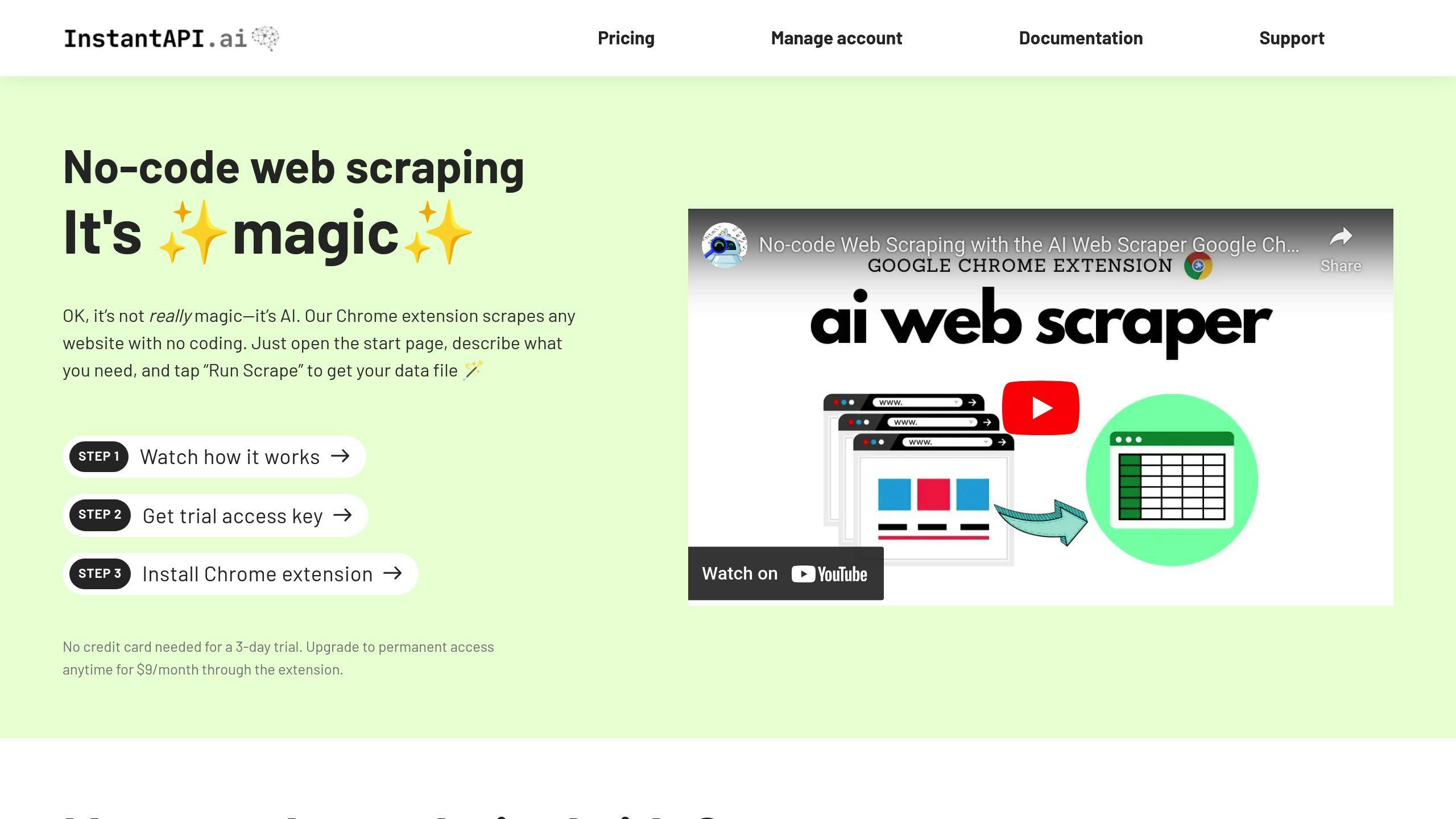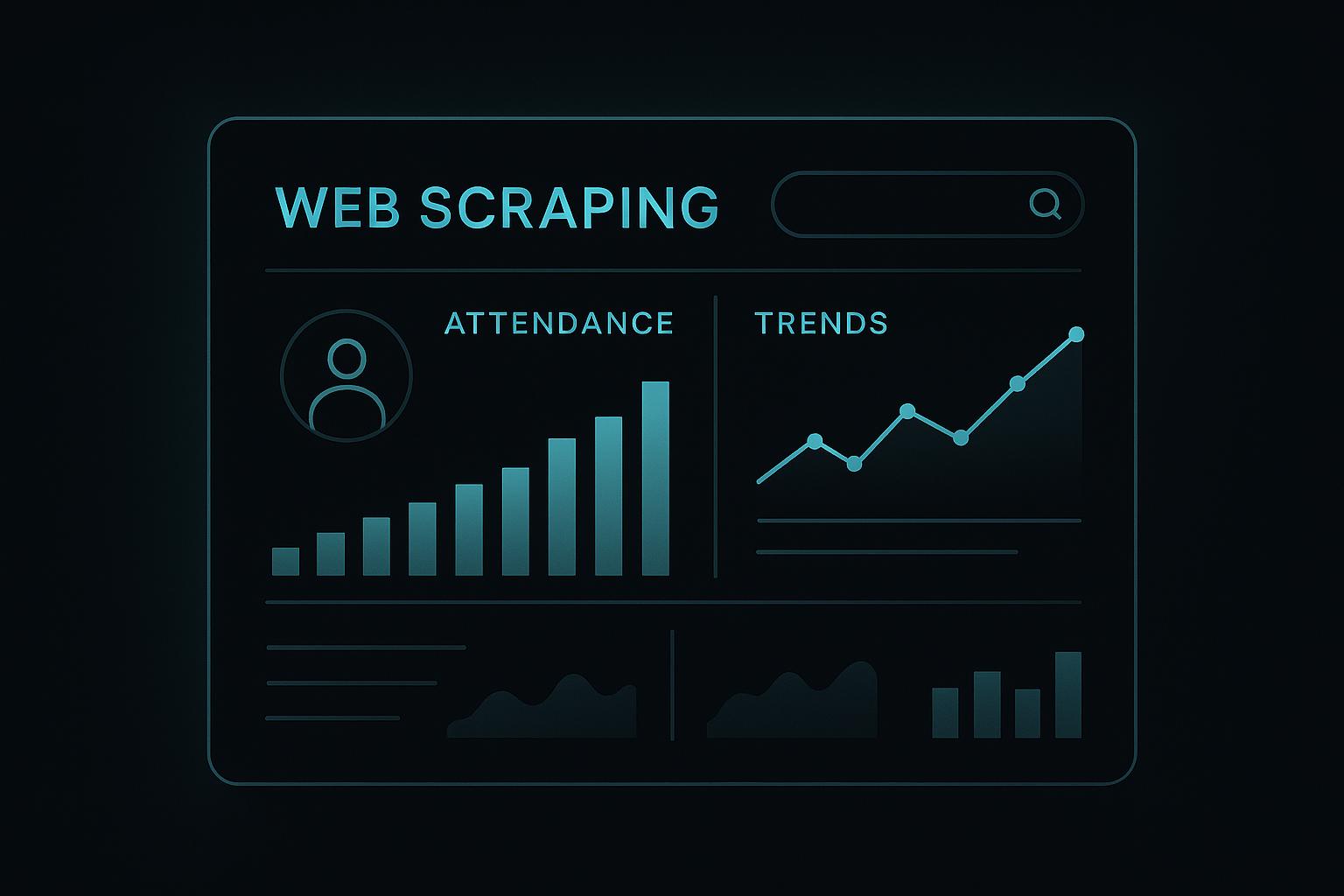AI is transforming data extraction by automating tasks, reducing errors, and processing information faster than traditional methods. Here's how it changes the game:
- Speed: Processes large datasets in minutes instead of hours or days.
- Accuracy: Less than 1% error rate compared to 5-15% with manual methods.
- Scalability: Easily handles massive data volumes without increasing costs.
- Adaptability: Adjusts to new data formats and unstructured sources automatically.
AI tools like machine learning, NLP, and computer vision power this shift, enabling businesses to extract data from text, images, and videos with precision. They save time, cut costs, and provide deeper insights. Tools like InstantAPI.ai and Octoparse offer accessible solutions for businesses to embrace this efficiency.
| Aspect | Traditional Methods | AI-Driven Approach |
|---|---|---|
| Processing Speed | Hours/days | Minutes/hours |
| Accuracy | 5-15% error rate | Less than 1% error rate |
| Adaptability | Manual updates required | Automatic adjustments |
| Cost | High (labor-intensive) | Reduced by up to 80% |
AI-driven data extraction is revolutionizing industries like healthcare, finance, and market research, offering faster, more reliable insights.
Related video from YouTube
Technologies Behind AI-Driven Pattern Recognition
AI-driven pattern recognition relies on three main technologies to process raw data and deliver actionable insights. Each plays a key role in making data extraction smarter and more efficient.
How Machine Learning Models Work
Machine learning models are at the heart of pattern recognition systems. They use algorithms to detect and categorize patterns in data. Here's how the process unfolds:
| Stage | Purpose |
|---|---|
| Data Acquisition | Collecting datasets from diverse sources |
| Pattern Analysis | Pinpointing features and uncovering relationships |
| Classification | Grouping data based on identified patterns |
These models improve over time by learning from new data, which helps them deliver more precise results.
Using Natural Language Processing (NLP)
Natural Language Processing (NLP) allows AI systems to grasp the context and meaning of text, going far beyond simple keyword detection. It pulls valuable information from unstructured sources like social media posts, business reports, and web pages.
NLP is particularly effective at understanding:
- Context and relationships between words
- Patterns in language usage
- Semantic meaning
- Structural elements within documents
Extracting Data from Images and Videos
Computer vision has transformed how visual data is processed. By analyzing images and videos, this technology can recognize visual features, extract text, and identify objects. Tasks that once required manual effort, like reading text from images or tagging objects in videos, are now automated.
When combined, machine learning, NLP, and computer vision create a robust system for extracting data across formats. This synergy offers businesses unmatched precision and efficiency, setting the stage for what’s next.
Advantages of Using AI for Data Extraction
AI has transformed how organizations handle data extraction, offering tools that process information more efficiently and accurately than ever before. These advancements have made AI a game-changer in modern data workflows.
Improved Accuracy and Speed
AI systems are built to deliver precise results and process data quickly, leaving traditional methods far behind. By leveraging machine learning and advanced pattern recognition, these systems reduce errors and speed up tasks that used to take hours or even days.
| Aspect | Traditional Methods | AI-Driven Extraction |
|---|---|---|
| Error Rate | 5-15% average | Less than 1% |
| Processing Speed | Hours/days | Minutes/hours |
| Pattern Recognition | Fixed rules | Dynamic and flexible |
| Adaptation to Changes | Manual updates | Automatic adjustments |
Deep learning plays a key role here, ensuring consistent performance across large datasets and easily scaling to handle increasing data volumes.
Adapting to Changing Data Sources
AI tools can automatically adjust to new data formats and layouts, unlike traditional systems that need constant manual updates. Whether it’s evolving web designs or shifting document structures, AI systems handle these changes effortlessly. For example, they can adapt to updates on e-commerce platforms, maintaining seamless data extraction for tasks like price tracking.
Lower Costs and Time Savings
AI reduces the need for manual data entry and error correction, cutting processing costs by as much as 80%, according to industry reports. It also boosts efficiency by:
- Eliminating repetitive manual tasks
- Allowing operations to scale without proportional cost increases
- Reducing the time spent fixing mistakes
These improvements help organizations save both time and money while maintaining high-quality results.
sbb-itb-f2fbbd7
Practical Uses and Tools for AI-Powered Data Extraction
Using AI for Market Research and Analysis
AI-powered data extraction has transformed the way businesses gather insights and stay competitive. Companies rely on AI tools to track competitor pricing, analyze customer sentiment, identify market trends, and stay updated on industry changes. In healthcare, organizations use these tools to analyze patient data from medical records, while financial institutions process detailed financial reports and regulatory documents. This ability to recognize patterns and extract meaningful data has become essential for modern market research.
Overview of InstantAPI.ai

InstantAPI.ai is a no-code platform designed to make AI-driven data extraction accessible to businesses of all sizes.
| Feature | What It Offers |
|---|---|
| No-Code Chrome Extension | Easy data extraction without needing tech skills |
| AI-Powered Scraping | Simplifies data collection with intelligent pattern matching |
| JavaScript Rendering | Handles dynamic website content seamlessly |
| Premium Proxies | Ensures reliable and uninterrupted data gathering |
| Automatic Updates | Keeps data extraction accurate over time |
At just $9 per month for unlimited scrapes via their Chrome extension, InstantAPI.ai is an affordable solution for businesses new to AI-powered data extraction. For larger needs, enterprise users can explore custom API solutions with advanced features.
Other AI Tools for Data Extraction
There are many tools available to address specific data extraction challenges. For example:
- Octoparse: Ideal for extracting e-commerce data.
- ParseHub: Great for working with websites that rely heavily on JavaScript.
- Import.io: Suited for large-scale enterprise operations.
When choosing an AI data extraction tool, think about factors like:
- How complex your data sources are
- The speed at which you need data processed
- How well the tool integrates with your existing systems
- Your budget
- The technical expertise within your team
The right tool will strike a balance between automation and control, tailored to your specific needs. While these tools already simplify data extraction, the potential for even more seamless integration and automation in the future is immense.
What's Next for AI in Data Extraction
Integrating Data from Multiple Sources
Neural networks are making it easier to combine data from various formats, such as text, images, and videos, into unified insights. For example, in 2023, a retailer used AI to merge customer reviews, social media sentiment, and sales data, leading to a 25% improvement in sales forecasting accuracy. Similarly, in healthcare, AI systems have cut diagnosis times by 30% by analyzing medical imaging and patient records at the same time.
| Integration Capability | Current Status | What’s Next |
|---|---|---|
| Text Analysis | Advanced NLP processing | Real-time multilingual understanding |
| Image Recognition | Accurate for structured data | Interpreting complex scenes |
| Audio Processing | Basic transcription and analysis | Context-aware understanding across languages |
| Video Analysis | Frame-by-frame processing | Real-time pattern recognition |
These capabilities are setting the stage for smarter automation across industries.
AI's Role in Automating Business Processes
AI is transforming how businesses manage workflows by using integrated data sources for more precise automation. It’s moving beyond basic tasks to systems that can:
- Adjust to changing data inputs
- Correct errors as they happen
- Handle unstructured data with near-human precision
This evolution ensures scalability while maintaining quality.
To get ready for what’s next, businesses should focus on:
- Building scalable AI infrastructure
- Establishing strong data governance policies
- Training teams to use AI tools effectively
- Prioritizing ethical AI practices
The future of AI in data extraction lies in systems that can autonomously process complex patterns, offering businesses a competitive edge.
Conclusion: The Impact of AI on Data Extraction
AI-powered pattern recognition has changed the way businesses handle data extraction, offering greater precision, speed, and scalability. By combining machine learning and natural language processing, organizations can now manage both structured and unstructured data with a level of accuracy that wasn’t possible before.
AI tools effortlessly adjust to changing data formats and layouts, removing the need for constant manual updates. They can process various data types - like text, images, audio, and video - allowing businesses to uncover deeper insights quickly. This has transformed industries such as healthcare and finance, where having accurate information readily available is critical for making decisions.
Beyond streamlining current processes, these tools open doors to more advanced uses. Businesses that embrace AI for data extraction gain more than just automation - they gain a powerful resource that enhances data quality and efficiency. This shift frees up time and resources, enabling teams to focus on innovation and driving strategic growth.
FAQs
Is regex used in web scraping?
Yes, regex plays an important role in data extraction, especially when working alongside AI-based tools that handle more complex, unstructured data. It’s excellent for identifying and extracting structured data patterns, while AI takes care of interpreting dynamic and context-driven content.
Regex is particularly useful for tasks like:
- Extracting emails, phone numbers, or HTML elements
- Cleaning and organizing datasets
When combined with AI, the two create a highly effective system:
- Regex focuses on precise pattern matching.
- AI tackles unstructured or context-heavy data.
- Together, they cover a wide range of data extraction needs.
Modern web scraping tools often integrate both regex and AI to balance accuracy and flexibility.
Pro Tip: Use tools like RegExr or Regex101 to test and validate your regex patterns before deploying them in your web scraping projects. This minimizes errors and ensures smoother data extraction.


